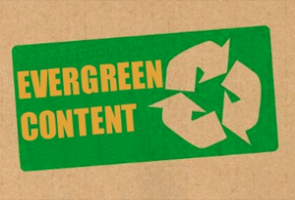Every good blog has several types of content. A well-rounded one doesn’t have a static feel to it; it stays on-point but doesn’t say the same thing over and over in every post. There are different ways to communicate with your audience that gets your message through while, at the same time, giving them a variety of content that keeps them interested.
There are four basic kinds of blog content:
• Seasonal content – reflects the interests of your audience at different times of year
• Targeted content – completely on-point with your marketing strategy
• Interest-based content – appeals to your audience’s broader interests
• Evergreen content – has universal appeal and defines your brand message
The most important of these is your evergreen content. It’s the glue that ties your blog together. Why? There are several reasons.
1. Evergreen content is timeless. Its popularity isn’t contingent on the same kinds of variables as other types of content. It sometimes needs to be tweaked a bit, but the general message (and most of the content) of the article remains the same.
2. Evergreen content adds value to your blog. It shows that you have something to say that is capable of getting attention and drawing your audience in. Most of all, its quality speaks not just for itself, but for your brand as well.
3. Evergreen content positions you as an authority. It proves that you know your stuff and that your opinions (along with your products and services) can be trusted.
Why It’s a Crucial Part of Your Blog
Evergreen content serves three basic purposes. It generates traffic; it draws in quality, targeted leads; and it helps your SEO. These three things actually work well together. Good SEO drives traffic, and people searching for keywords in your content obviously want the information contained in it. Since evergreen content isn’t cycled on and off your site, it always points to relevant content. In short, it keeps working for you long after you post it – sometimes for years at a time.
So What Will Work Best For Your Niche?
Here comes my classic response: “It depends.”
The simple fact of the matter is that I can’t tell you what’s going to work best for your niche. I can, however, give you a reliable formula to follow to figure out the answer on your own.
Start by analyzing your blog. See which of your articles gets the most hits. The ones that top your list are likely evergreen topics. The ones at the bottom are obviously not. These pieces of content should follow at least a loose pattern.
Take as an example a blog on sports. Blog posts about specific games or current season statistics for a specific player are not evergreen. Posts about things like the benefits of artificial turf might be, especially if your blog is about sports medicine or safety … or, for that matter, turf.
You can narrow your search even more by eliminating top posts that don’t directly relate to your main topic. If you do happen to be in the turf business, you want to compare the posts about turf and see what subtopic gets the best engagement. Is it the safety of turf, the technology, the durability, the variety of uses, or something else? Whatever emerges as the most popular topic is where you should be building evergreen content – clearly, it’s the thing with which your audience best identifies.
Next, update regularly. Populate your blog with content on your leading topic and keep analyzing. Cycle out articles that underperform and concentrate attention on the ones that get the best engagement. Tweet about them. Boost your Facebook posts about them. Get on your email list and generate some excitement around them.
Finally, test with specific calls to action. Whatever purpose your blog content is supposed to serve, use your top posts to motivate readers toward a specific action. Don’t just inform – motivate, challenge, and create an atmosphere of expectancy for both the desired action and the most positive outcome for the reader. Where you see the best results is where you will find the best evergreen content for your niche, based on how you approach it.
It’s a simple formula, but it will take some work on your part to fine-tune the process. Web content writing is, after all, a huge numbers game. Keep in mind that your content can fall flat at a ratio of 10:1 against articles that will have long-term appeal. Be persistent and do your homework, and you will find the long-term benefits to be well worth the effort.
